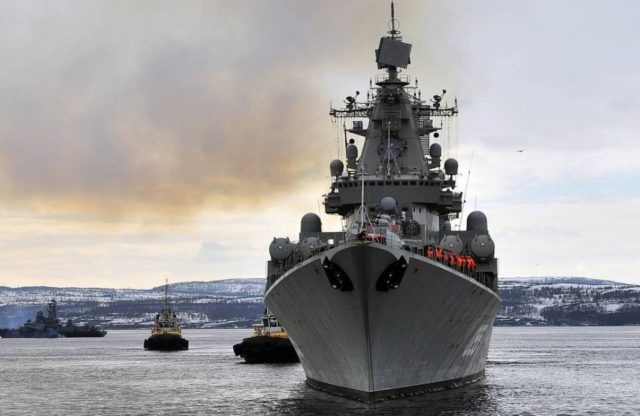
Russia’s Northern Fleet Upgraded to Military District Status
Publication: Eurasia Daily Monitor Volume: 18 Issue: 3
By:

On January 1, 2021, Russia’s Northern Fleet was officially upgraded to the status of a Military District (MD), as part of a reorganization of the overall system of MDs. This marks a significant change to the national organizational structure of the MDs in Russia; and it marks the first major shift away from the concept of reducing and simplifying the number and functions of these, which, since 2010, have also had the status of Joint Strategic Commands (Obyedinennyye Strategicheskoye Komandovanie—OSK). The reform in 2010 reduced the number of Russian MDs from six to four (Western, Southern, Central and Eastern) and subordinated all military units and assets within each MD to the contiguous, respective OSK. In effect, the Northern Fleet has now gained both the status of an MD and OSK, and this may well be a prelude to future organizational modifications within the Russian Armed Forces (Interfax, January 4, 2021).
Last month (December 21, 2020), President Vladimir Putin signed an ukaz (decree) to upgrade the Northern Fleet to MD status, effective from January 1, 2021: “To consider the Northern Fleet an inter-specific strategic territorial association of the Armed Forces of the Russian Federation, performing the tasks of a military district.” According to the ukaz, the change is associated with measures to protect the integrity and inviolability of the Russian Federation and to defend the country’s northern borders as well as Moscow’s evolving interests in the Arctic (Izvestia, December 21, 2020).
Earlier, in June, Putin signed a preliminary ukaz declaring that the Northern Fleet would henceforth have the status of a separate military-administrative unit. Additionally, some portions of the Western MD were “cut” and moved to the new Northern Fleet MD: the Republic of Komi, the Arkhangelsk and Murmansk regions, as well as the Nenets Autonomous District. The former Commander of the Northern Fleet, Admiral Vyacheslav Popov explained, “From January 1, 2021, the Northern Fleet will de jure perform the tasks of the military district, which exist de facto. This, in particular, involves the solution of issues of mobilization, conscription, interaction with authorities, [as well as] the creation and development of the infrastructure of the Northern Sea Route” (Rossyiskaya Gazeta, December 22, 2020).
The commander of the Northern Fleet, Admiral Alexander Moiseev also noted the Arctic dimension in this latest administrative change: “By the decree of the president of the Russian Federation, the status of the Northern Fleet from January 1, 2021, is legally equated to the status of the military district as the main military-administrative unit preparing for armed defense and the very protection of the integrity and inviolability of the Russian Federation, including territories within the boundaries of its subjects, along a certain strategic direction—the Arctic.” In December 2014, the Northern Fleet was officially withdrawn from the Western MD and, on its basis, the authorities formed the North OSK, which was reinforced with assets drawn from the other MDs (Interfax, January 4, 2021).
On January 4, Admiral Moiseev stated that the primary task of the Northern Fleet will remain to maintain the combat readiness of the naval strategic nuclear forces: “Based on its mission, the group is kept in constant readiness to carry out the tasks of deterrence from unleashing aggression against the Russian Federation” (Izvestia, January 4, 2021). However, the Northern Fleet will also continue to spearhead Russia’s ongoing exploration and patrolling of Arctic waters. Two days earlier, the fleet headquarters confirmed plans to conduct an expedition to the Novaya Zemlya archipelago in the summer of 2021. The study of the Arctic will continue, together with the assistance of the Russian Geographical Society (Izvestia, January 3, 2021).
The Northern Fleet commander additionally noted that submarines will remain active in Arctic waters. According to Moiseev, “[T]he submariners of the Northern Fleet will continue the practice of ice sailing in the Arctic Ocean, as well as performing combat patrol and combat duty tasks in other areas of the World Ocean.” In 2020, as part of the modernization of the Russian Military-Maritime Fleet (Voyenno-Morskoy Flot—VMF), the Northern Fleet received into service a Borei-A strategic missile submarine, the Knyaz Vladimir. This is the second standard (strategic submarine) carrier of the Bulava intercontinental ballistic missile (ICBM) in the Northern Fleet. In December 2020, during the testing of the strategic nuclear forces, the Karelia strategic missile submarine in the Northern Fleet successfully launched the Sineva ICBM from a designated area in the Barents Sea at the Kura test site in Kamchatka. Currently, Project 667BDRM Delfin submarines, armed with Sineva ICBMs, together with the new Borei-A submarines armed with Bulava ICBMs, form the backbone of Russia’s naval strategic nuclear forces (Hibiny.com, January 4, 2021).
This latest change to the status of the Northern Fleet seems to conclude the process that began in December 2014. It appears to walk back the conceptual idea of the OSK; but in real terms, it offers a unique role to the Northern Fleet that is not afforded to any other part of the VMF. Since 2010, the fleets and Caspian Flotilla were subordinate to each respective OSK; now the Northern Fleet has the same status as the other four MDs/OSKs. Driven by what the political-military leadership considers Russia’s long-term strategic interests in the Arctic (see EDM, June 18, 2018, March 16, 2020, November 9, 2020), this upgrade to the status of the Northern Fleet is a powerful signal to other actors of the importance of this region in Russian defense planning.



